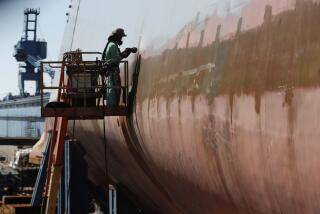It Is Time to Call the Shuttle Obsolete
- Share via
“Oh, it’s flashing, it’s flashing terribly. It’s bursting into flames and falling on the mooring mast. Oh, this is one of the worst catastrophes--the flames are leaping 400, 500 feet into the sky. It’s a terrific crash, ladies and gentlemen, the smoke and the flames. And now it’s crashing to the ground, not quite at the mooring mast. Oh, the humanity!”
Those were the words of radio announcer Herb Morrison as he witnessed the explosion of the dirigible Hindenburg in 1937. The explosion of the Challenger will have similar significance. The Hindenburg exposed the flaws in the dirigible as a passenger carrier, showing it to be an obsolete technology that could not compete with its rival, the airplane. The Challenger disaster, in turn, will point to the shuttle as a technology that is not only obsolete but also irrelevant.
Challenger points out the folly that NASA has been pursuing for nearly 30 years: not to provide the nation with the routine and reliable space-launch services that it needs, but to pursue a sequence of showy space spectaculars. The result has been the Apollo and shuttle programs, which have stood largely as monuments to themselves. By contrast, the routine launching of useful satellites has taken a back seat.
Remarkably, NASA has deliberately given itself no alternative to the shuttle for launching satellites. All its satellite-launching capability has been in four shuttle orbiters--one of which has now blown up. Inevitably, then, many important satellites will sit on the ground for months, or even years, as investigations and studies take up much of NASA’s time.
The Europeans have not been so foolish. They have the Ariane, an unmanned rocket that they have been launching with good success. It has had failures, but those problems have not brought the sort of national grief that we associate with presidential assassinations. NASA used to have a stable of similar unmanned rockets, but it gave them up, putting all its eggs into the shuttle basket. The usefulness of such rockets as well as the folly of using expensive and rare shuttle spacecraft for routine satellite launches now is clear.
NASA has said that beyond the shuttle the “next logical step” is the space station. Instead, it should be clear that the next logical step is to face up to the limits of the shuttle as a technology. With its rockets, it can only carry 1 1/2% of its takeoff weight to orbit as passengers or cargo.
This highly marginal performance represents the best that can be done with rockets, even in their current advanced state of development. Thus from the Challenger disaster we should gain determination to go beyond the rocket and to build airplane-like craft to fly to orbit.
The Air Force currently is pursuing the development of its advanced aerospace plane, which will fly like an airplane from a runway, breathing oxygen taken from the air. This contrasts with the shuttle, which carries more than 600 tons of liquid oxygen in a fuel tank. The aerospace plane will rely on new engines called scramjets, with up to 10 times better performance than the rocket. With these engines, space flight may in time become as routine as the flight of aircraft. A space launch will no longer be a media event. Its failure will not bring national mourning.
Nevertheless, Challenger’s loss will not be in vain if it leads NASA into a major change of course.
NASA must abandon its exclusive reliance on the shuttle, saving those valuable craft for the rare occasions when they are indispensable. NASA must return to the tried and true unmanned rocket, thus assuring the nation that it can launch our satellites reliably and routinely. And NASA must look beyond the rocket, seeking its eventual replacement. Then, like the Hindenburg, Challenger may someday be remembered as having marked the advent of newer and better methods of flight.
More to Read
Sign up for Essential California
The most important California stories and recommendations in your inbox every morning.
You may occasionally receive promotional content from the Los Angeles Times.













